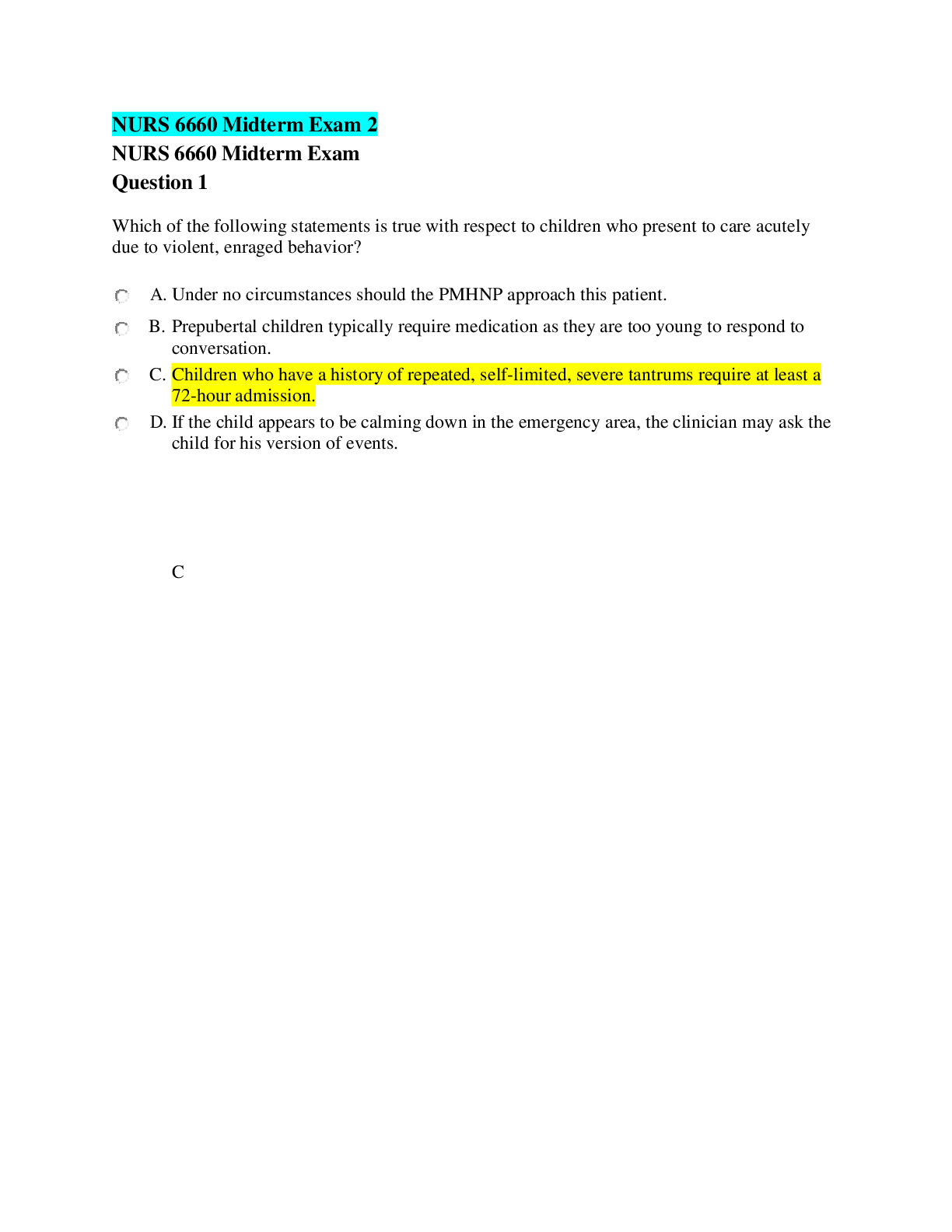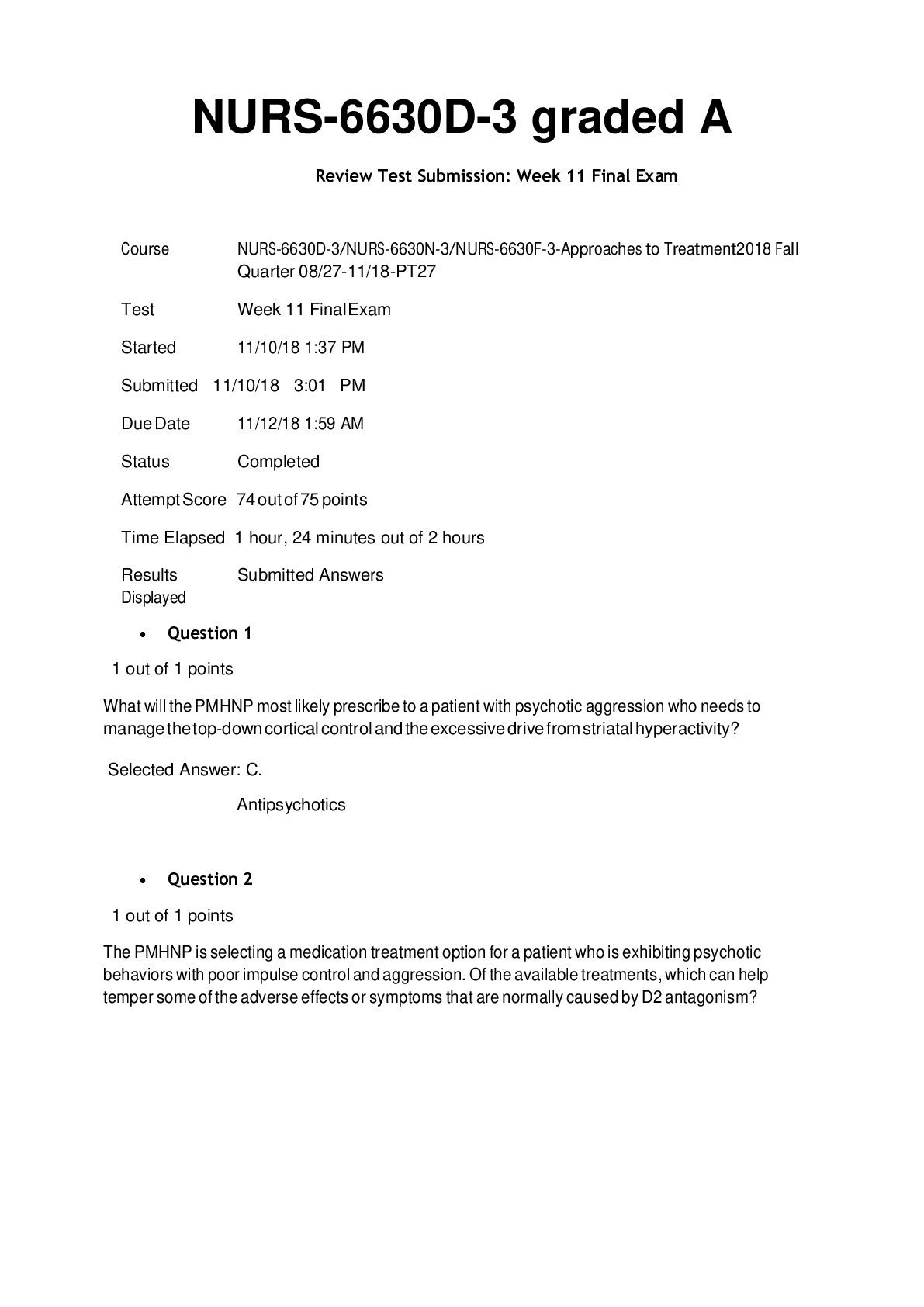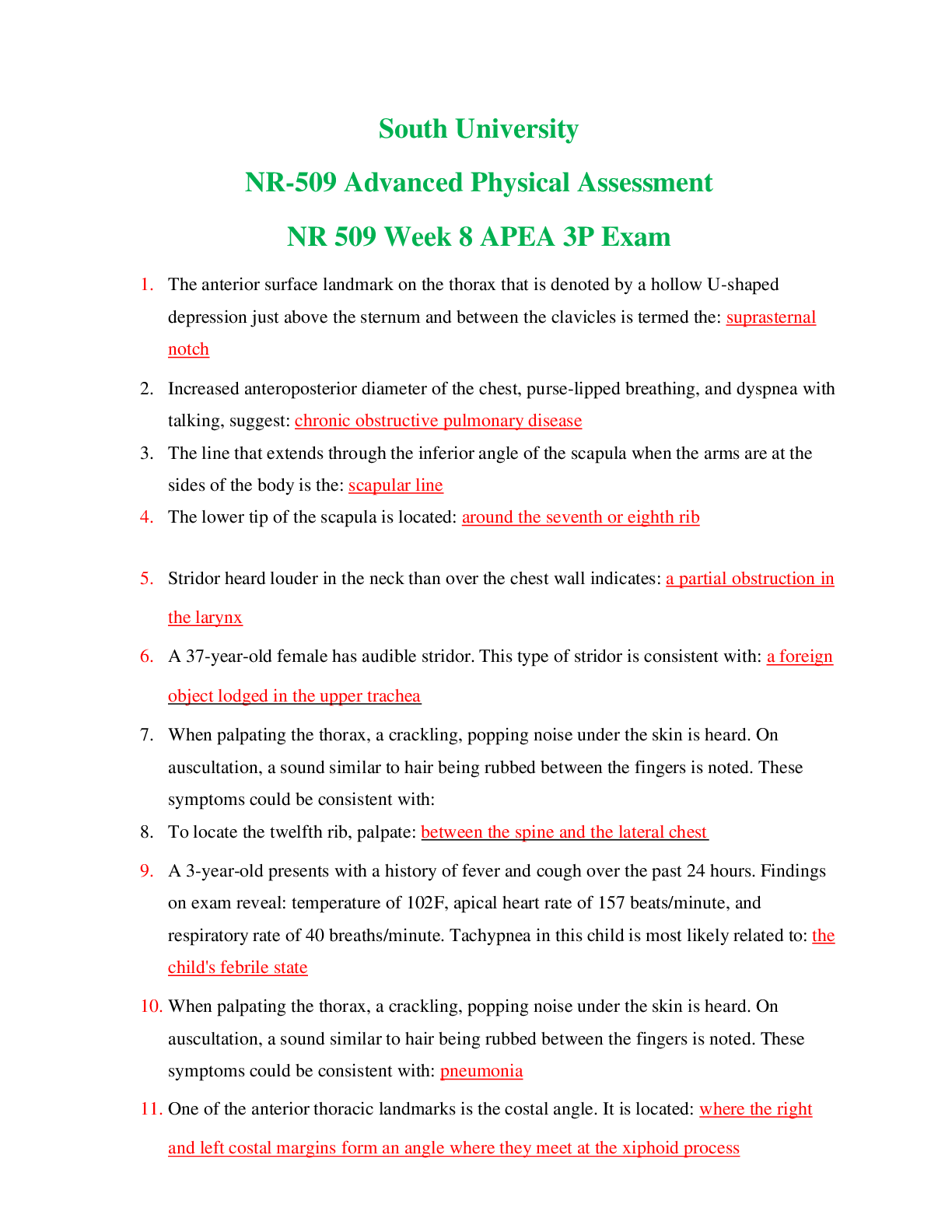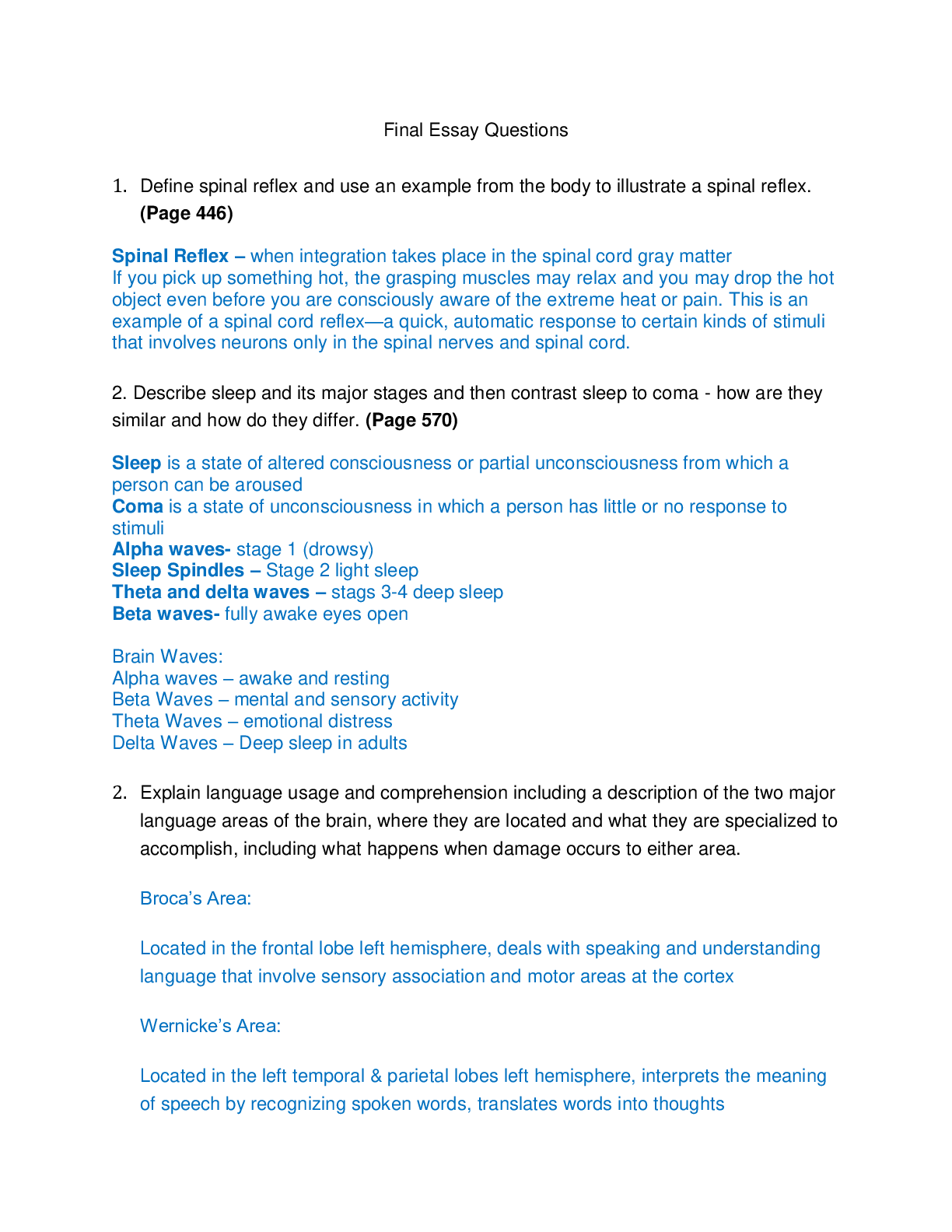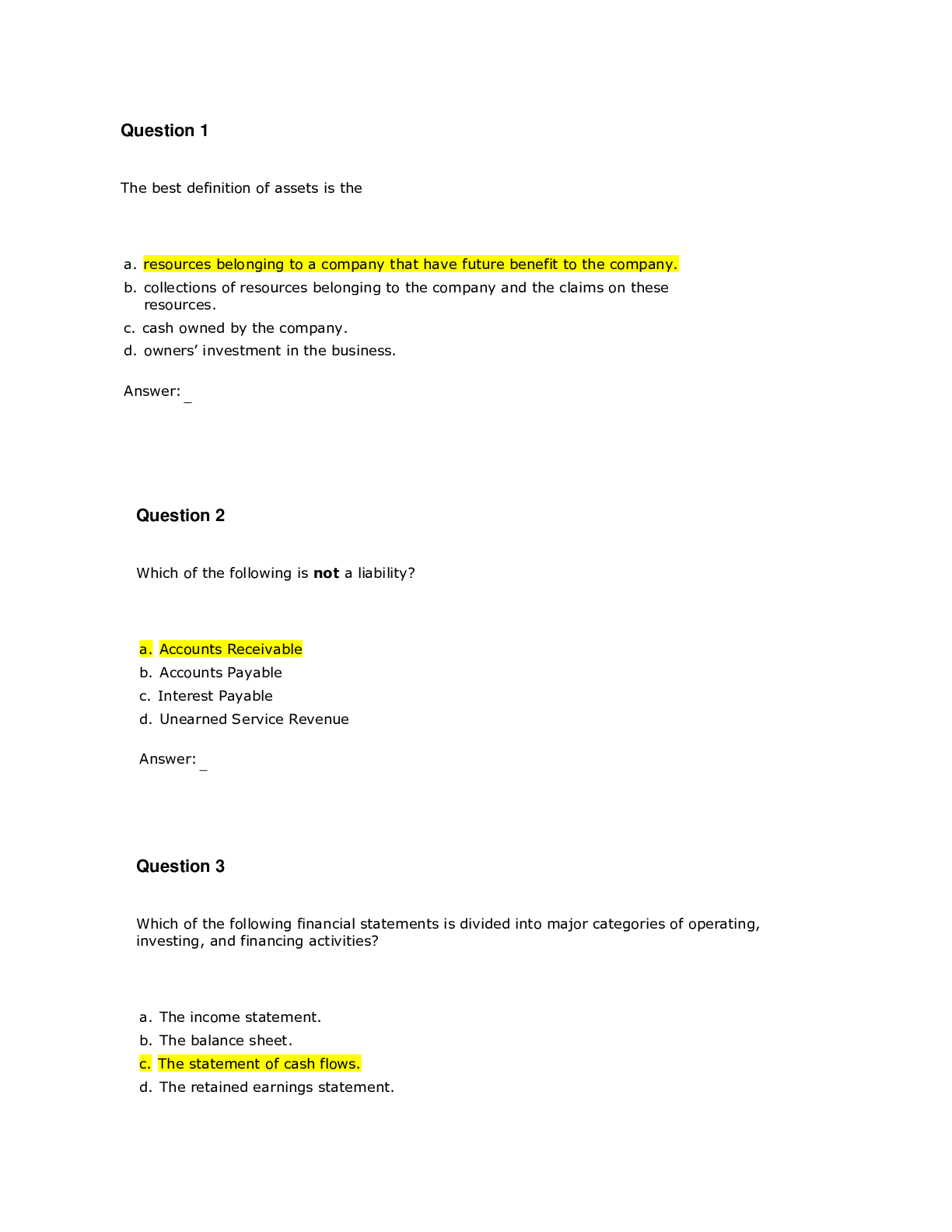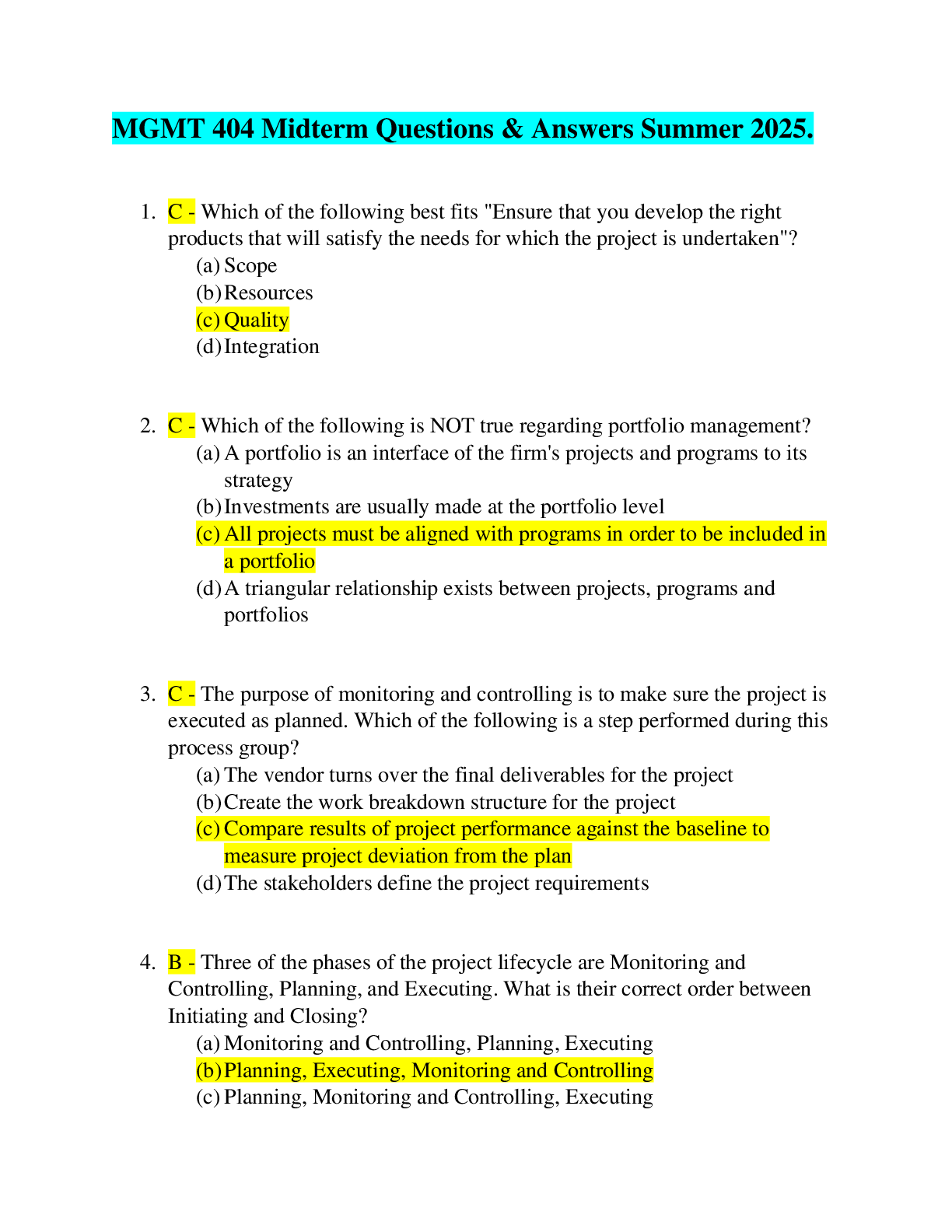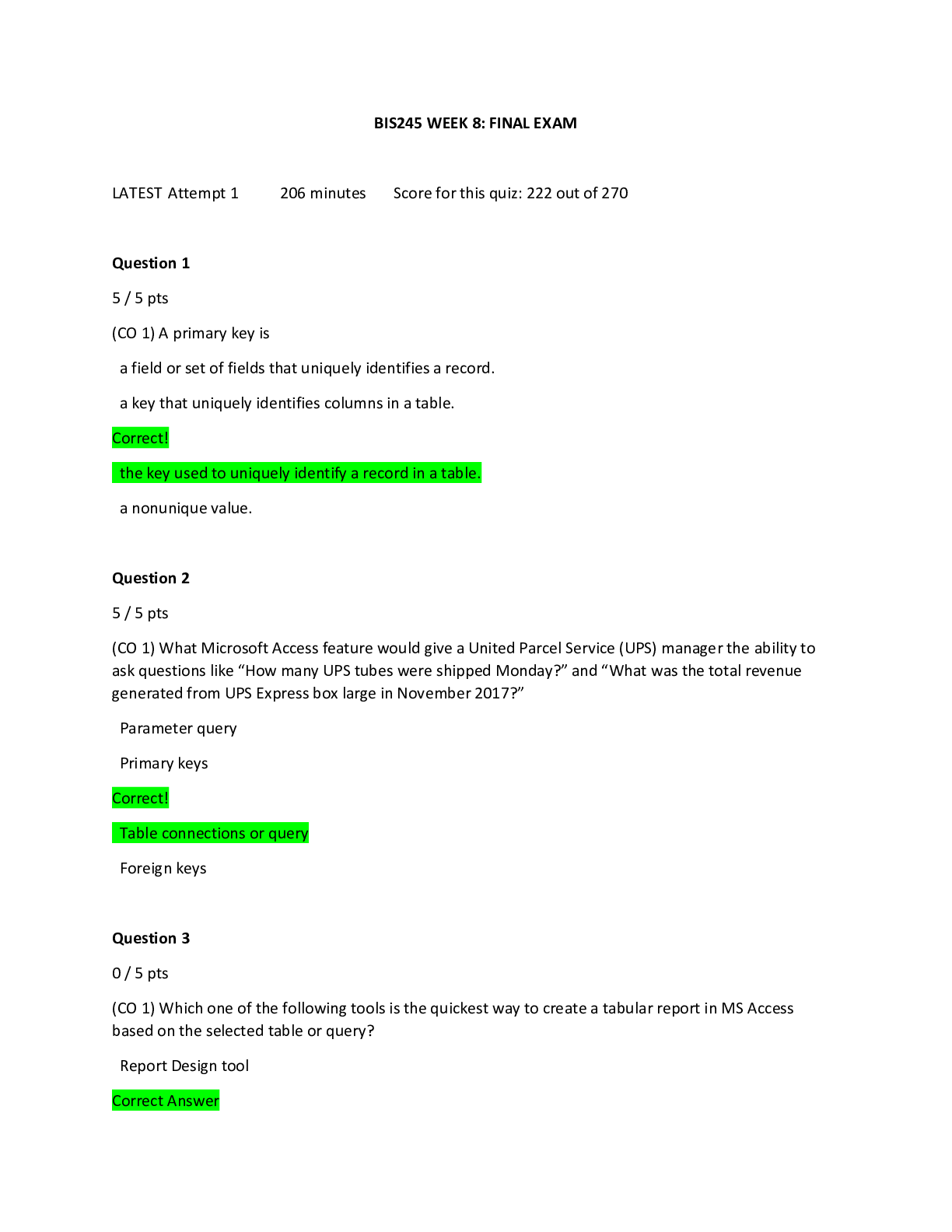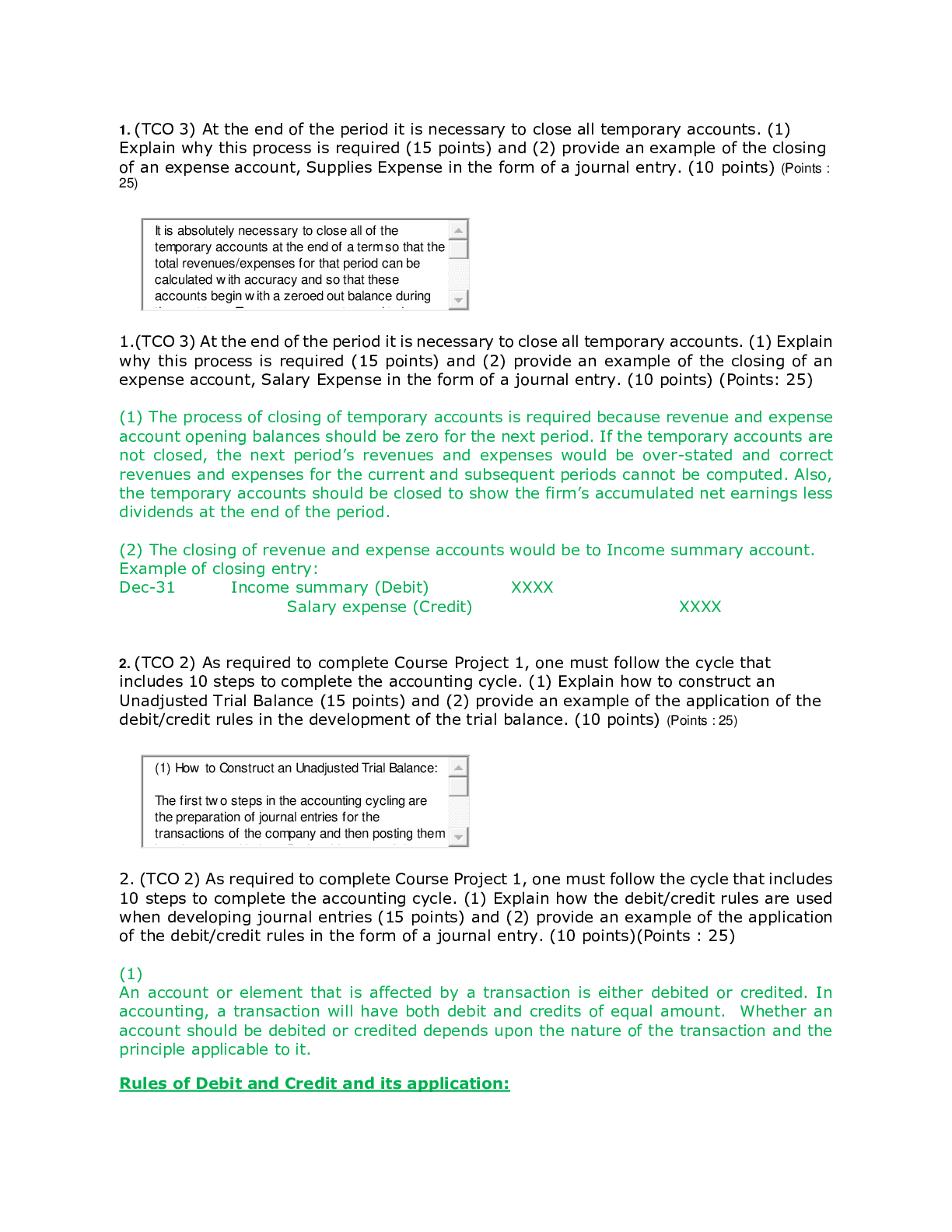Biology > EXAM > BIOS 105 Quizzes & Midterm Exam | Updated Fall 2025/2026 | All Answers Verified. A+ Work (All)
BIOS 105 Quizzes & Midterm Exam | Updated Fall 2025/2026 | All Answers Verified. A+ Work
Document Content and Description Below
Collections of Bios 105 Quizzes & Midterm 1. Question : (TCO1) Which of these is NOT a survival need: oxygen body temperature reproduction nutrients w... ater Points Received: 2 of 2 Comments: Question 2. Question : (TCO1) Your body thermostat is located in a part of the brain called the hypothalamus. Which of the following elements of a control system does this area in the brain represent: stimulus afferent pathway effector efferent pathway control center Points Received: 2 of 2 Comments: Question 3. Question : (TCO1) Which ventral cavity subdivision has no bony protection: pelvic abdominal cranial thoracic spinal Points Received: 2 of 2 Comments: Question 4. Question : (TCO1) The lungs and heart are in the __________ body cavity. spinal dorsal thoracic abdominopelvic cranial Points Received: 2 of 2 Comments: Question 5. Question : (TCO1) The ribs are located in the: right and left lumbar regions right and left pubic regions right and left inguinal regions right and left hypochondriac regions right and left iliac regions Points Received: 2 of 2 Comments: Question 6. Question : (TCO1) Which of the following orientation and directional terms have the same meaning (in humans) : inferior and cranial inferior and cephalad superior and caudal anterior and dorsal anterior and ventral Points Received: 2 of 2 Comments: Question 7. Question : (TCO2) Ninety-six percent of the human body is composed of the elements: sodium, potassium, hydrogen, and sulfur carbon, oxygen, hydrogen, and nitrogen calcium, magnesium, potassium, and iron carbon, oxygen, iron, and potassium carbon, calcium, sodium, and oxygen Points Received: 2 of 2 Comments: Question 8. Question : (TCO2) Which of the following statements is correct regarding the electrical charge of subatomic particles: protons are negatively charged, electrons are positively charged, and neutrons are neutral protons are negatively charged, electrons are neutral, and neutrons are negatively charged protons are positively charged, electrons are negatively charged, and neutrons are neutral protons are neutral, electrons are negatively charged, and neutrons are positively charged protons are positively charged, electrons are neutral, and neutrons are negatively charged Points Received: 2 of 2 Comments: Question 9. Question : (TCO2) When a pair of electrons is shared equally between two atoms, the bond formed is called a(n) : hydrogen bond carbon bond polar covalent bond ionic bond nonpolar covalent bond Points Received: 2 of 2 Comments: Question 10. Question : (TCO2) Glucose and starch are examples of: triglycerides proteins carbohydrates steroids phospholipids Points Received: 2 of 2 Comments: Question 11. Question : (TCO2) Which of the following substances below is matched with its correct organic group: DNA - lipids steroids - carbohydrates monosaccharides - nucleic acids glycerol - proteins enzymes - proteins Points Received: 2 of 2 Comments: Question 12. Question : (TCO2) Water is useful in body processes because: it is a good solvent it acts as an enzyne it has a low heat capacity it is chemically inert it is a product in hydrolysis reactions Points Received: 2 of 2 Comments: 1. Question : (TCO3) The correct order of phases of the cell cycle is: interphase, prophase, metaphase, anaphase, telophase prophase, interphase, metaphase, anaphase, telophase telophase, metaphase, anaphase, prophase prophase, metaphase, anaphase, telophase metaphase, anaphase, prophase, telophase Points Received: 2 of 2 Comments: Question 2. Question : (TCO3) The molecule that carries an amino acid to the ribosome for incorporation into a protein is: DNA messenger RNA (mRNA) ATP ribosomal RNA (rRNA) transfer RNA (tRNA) Points Received: 2 of 2 Comments: Question 3. Question : (TCO3) Looking into a microscope, you notice cells swimming, propelled by a long tail. What cell structure must these cells have in order to be mobile: 8 ribosomes cytoplasm smooth ER flagella peroxisomes Points Received: 2 of 2 Comments: Question 4. Question : (TCO3) Two types of active transport are osmosis and endocytosis endocytosis and diffusion diffusion and filtration filtration and exocytosis endocytosis and exocytosis Points Received: 2 of 2 Comments: Question 5. Question : (TCO5) Epidermal cells that are actively mitotic and replace superficial cells that are continually rubbed off are: stratum granulosum cells stratum corneum cells stratum germinativum cells stratum spinosum cells stratum lucidum cells Points Received: 0 of 2 Comments: Question 6. Question : (TCO5) Melanocytes are found in the: stratum lucidum stratum granulosum stratum corneum stratum spinosum stratum basale Points Received: 2 of 2 Comments: Question 7. Question : (TCO5) Although you get wet while swimming, a tough protein within the skin prevents it from soaking up moisture like a sponge. This substance is: keratin serous fluid melanin carotene mucus Points Received: 2 of 2 Comments: Question 8. Question : (TCO5) Which of the following relationships is incorrect: visceral pleura - lines the surface of the lungs parietal pleura - lines the wall of thoracic cavity parietal pericardium - covers the inner surface of the heart visceral peritoneum - covers the outer surface of the small intestine parietal peritoneum - lines the wall of the abdominal cavity Points Received: 2 of 2 Comments: Question 9. Question : (TCO4) The epidermis is composed of: areolar tissue stratified squamous epithelium dense fibrous connective tissue simple columnar epithelium adipose tissue Points Received: 2 of 2 Comments: Question 10. Question : (TCO4) The tissue that is usually well vascularized and has an extensive extracellular matrix is called: connective tissue brain tissue nervous tissue muscle tissue epithelial tissue Points Received: 2 of 2 Comments: Question 11. Question : (TCO4) Which of the following is NOT connective tissue: adipose cartilage bone skeletal muscle blood Points Received: 2 of 2 Comments: Question 12. Question : (TCO4) Which of these characteristics best describes cardiac muscle tissue: movement is voluntary and cells possess striations movement is involuntary and cells possess striations multinucleate and long, cylindrical cells single nucleus and spindle-shaped cells attached to the skeleton 1. Question : (TCO6) There are __________ vertebrae in the neck region. five thoracic five lumbar seven cervical seven lumbar twelve thoracic Points Received: 2 of 2 Comments: Question 2. Question : (TCO6) Which of these bones is NOT a long bone found in the leg: patella fibula metatarsals tibia femur Points Received: 2 of 2 Comments: Question 3. Question : (TCO6) Fingers and toes are referred to as: carpals tarsals phalanges metacarpals metatarsals Points Received: 2 of 2 Comments: Question 4. Question : (TCO6) The factor(s) that determine where bone matrix is to be remodeled is (are): calcium level of the blood stresses of gravity and muscle pull on the skeleton sex hormones growth hormone parathyroid hormone (PTH) Points Received: 2 of 2 Comments: Question 5. Question : (TCO6) Which is the correct order of ribs, from superior to inferior: floating ribs, false ribs, true ribs true ribs, false ribs, floating ribs floating ribs, true ribs, false ribs false ribs, floating ribs, true ribs true ribs, floating ribs, false ribs Points Received: 2 of 2 Comments: Question 6. Question : (TCO6) Articulations permitting only slight degrees of movement are __________, whereas articulations permitting no movement are called __________. diarthroses; synarthroses synarthroses; amphiarthroses diarthroses; amphiarthroses amphiarthroses; synarthroses amphiarthroses; diarthroses Points Received: 2 of 2 Comments: Question 7. Question : (TCO7)Which of the following muscles are antagonists: biceps brachii and triceps brachii masseter and temporalis vastus medialis and vastus lateralis gastrocnemius and soleus biceps femoris and biceps brachii Points Received: 2 of 2 Comments: Question 8. Question : (TCO7) Acetylcholine is: a source of energy for muscle contraction an ion pump on the postsynaptic membrane an oxygen-binding protein a component of thick myofilaments a neurotransmitter that stimulates skeletal muscle Points Received: 2 of 2 Comments: Question 9. Question : (TCO7) A sarcomere is: the contractile unit between two Z discs a compartment in a myofilament the wavy lines on the cell, as seen in a microscope the nonfunctional unit of skeletal muscle the area between two intercalated discs Points Received: 2 of 2 Comments: Question 10. Question : (TCO7) Muscle tissue that has involuntary regulation of contraction is: cardiac muscle only cardiac muscle and skeletal muscle smooth muscle only cardiac muscle and smooth muscle skeletal muscle only Points Received: 2 of 2 Comments: Question 11. Question : (TCO6) The axial skelton contains which of the folowing 1. skull 2. arms and legs 3. ribs and sternum 4. vertebrae 5. pelvic girdles 2, 5 1, 2, 3, 5 1, 3, 4, 5 2, 3, 4, 5 1, 3, 4 Points Received: 2 of 2 Comments: Question 12. Question : (TCO7) Which of these events must occur first to trigger the skeletal muscle to generate an action potential and contract: acetylcholine (ACh) causes temporary permeability to sodium acetylcholinesterase (AchE) breaks down acetylcholine (ACh) operation of the sodium-potassium pump diffusion of potassium ions out of the cell sodium ions rush into the cell Points Received: 2 of 2 Comments: 1. Question : (TCO8) The vital centers for the control of visceral activities such as heart rate, breathing, blood pressure, swallowing, and vomiting are located in the: medulla oblongata cerebrum pons hypothalamus midbrain Points Received: 2 of 2 Comments: Question 2. Question : (TCO8) Impulse conduction is fastest in neurons that are: myelinated motor sensory unmyelinated cerebral Points Received: 2 of 2 Comments: Question 3. Question : (TCO8) The neuron processes that normally receive incoming stimuli are called: neurolemmas Schwann cells dendrites axons satellite cells Points Received: 2 of 2 Comments: Question 4. Question : (TCO8) The fibrous outermost tunic seen anteriorily as the "white of the eye" is the: sclera fovea centralis cornea retina choroid Points Received: 2 of 2 Comments: Question 5. Question : (TCO8) The three sets of color receptors within the retina are sensitive to wavelengths of visible light that are: red, green, and yellow blue, green, and red orange, green, and purple red, blue, and yellow green, yellow, and purple Points Received: 2 of 2 Comments: Question 6. Question : (TCO9) An enlargement of the thyroid gland resulting from a deficiency of dietary iodine is called: goiter myxedema acromegaly exophthalmos cretinism Points Received: 2 of 2 Comments: Question 7. Question : (TCO9) The body's major metabolic hormone is called: adrenaline calcitonin growth hormone thyroid hormone prolactin Points Received: 2 of 2 Comments: Question 8. Question : (TCO9) Most endocrine organs are prodded into action by other hormones; this type of stimulus is called: neural stimulus hormonal stimulus steroid stimulus humoral stimulus receptor-mediated stimulus Points Received: 2 of 2 Comments: Question 9. Question : (TCO7) Which one of the following is composed of myosin protein: Z discs all myofilaments thin filaments thick filaments light bands Points Received: 0 of 2 Comments: Question 10. Question : (TCO6) A bone fracture where the bone is broken into many fragments is a: simple fracture greenstick fracture compound fracture comminuted fracture compression fracture Points Received: 2 of 2 Comments: Question 11. Question : (TCO5) Which of the following is an indication of melanoma: a pigmented spot that has smooth borders a symmetrical mole a spot on the skin that is smaller than the size of a pencil eraser a pigmented spot that contains areas of different colors a pigmented spot that is black Points Received: 2 of 2 Comments: Question 12. Question : (TCO4) Which type of tissue conducts electrochemical impulses: connective tissue epithelial tissue muscle tissue nervous tissue dense tissue Points Received: 2 of 2 Comments: Question 13. Question : (TCO3) Which of these characteristics best describes cardiac muscle tissue: movement is voluntary and cells possess striations movement is involuntary and cells possess striations multinucleate and long, cylindrical cells single nucleus and spindle-shaped cells attached to the skeleton Points Received: 2 of 2 Comments: Question 14. Question : (TCO2) The atomic number of an atom reveals the number of: neutrons plus electrons protons in the atomic nucleus protons plus electrons electrons in the atomic nucleus protons plus neutrons Points Received: 2 of 2 Comments: Question 15. Question : (TCO1) Which of the following is the correct order of elements in a control system: stimulus, receptor, efferent pathway, control center, afferent pathway, effector, response receptor, stimulus, afferent pathway, control center, efferent pathway, effector, response receptor, stimulus, efferent pathway, control center, afferent pathway, effector, response stimulus, receptor, afferent pathway, control center, efferent pathway, effector, response effector, stimulus, efferent pathway, control center, afferent pathway, receptor, response Points Received: 2 of 2 Comments: 1. Question : (TCO 1) Match the following anatomical terms to their meaning :Inferior » 5 : Below :Dorsal » 6 : Behind :Lateral » 2 : toward the side :Distal » 8 : farther from the origin of the body part or the point of attachment of a limb to the body trunk :Medial » 1 : ftoward the midline :Superior » 7 : above :Proximal » 4 : close to the origin of the body part or the point of attachment of a limb to the body trunk :ventral » 3 : in front of Instructor Explanation: page 18 Points Received: 8 of 8 Comments: Question 2. Question : (TCO 1) Match the follwing systems to their function : forms external body covering » 6 :integumentary system : maintains posture » 3 : muscular system : carries oxygen to body tissues » 1 :cardiovascular : regualtes body processes such as growth and reproduction » 4 : endocrine system : elimnates nitrogenous wastes from the body » 2 : urnary system : breaks down food » 5 : digestive system Instructor Explanation: pp 4-7 Points Received: 6 of 6 Comments: Question 3. Question : (TCO 3) Match the following : nucleus » 7 : contains the genetic material : mitochondria » 8 : the powerhouse of the cell : cilia » 4 : whiplike cellular extensions the move substances across the cell surface : lysosomes » 6 : carry powerful digestive enzymes : flagella » 3 : in the human body, only spem have this structure : cytosol » 2 : semi transparent fluid filling the cell : Golgi apparatus » 5 : modifies and packages proteins for their final destination : ribosomes » 1 : site of protein synthesis Instructor Explanation: pp17,18 Points Received: 6 of 8 Comments: Question 4. Question : (TCO 4)Match the tissue type with its function : Nervous tissue » 2 : receives and conducts electrochemial impulses : Connective tissue » 3 : binding together body other body tissues : Epithelial Tissue » 1 : protection : Muscular Tissue » 4 : to produce movement Points Received: 4 of 4 Comments: Question 5. Question : TCO 6)Match the following : Wrist joint » 2 : plane joint : shoulder joint » 1 : ball and socket joint : elbow joint » 5 : hinge joint : knuckle joint » 3 : condyloid joint : joint between axis and atlas » 4 : pivot joint Instructor Explanation: pp 170-172 Points Received: 3 of 5 Comments: Question 6. Question : ( TCO 7) Match the following : muscle twitch » 3 : single brief jerky contractions : tetanic contraction » 4 : smooth sustained contraction due to rapid stimul : isotonic contractions » 1 : muscle shortens during this contraction : isometric contraction » 2 : muscle does not shorten during this contraction : muscle tone » 5 : a state of continuous partial contraction Points Received: 5 of 5 Comments: Question 7. Question : ( TCO 8) Match the following : white of the eye » 5 : sclera : pinna » 7 : outer ear : malleus, incus and stapes » 6 : ossicles : contains millions of photoreceptors » 3 : retina : provide our peripheral vision » 4 : rods : responsible for color vision » 1 : cones : contains the hearing receptors » 8 : organ of Corti : eardrum » 2 : tympanic membrane Points Received: 8 of 8 Comments: Question 8. Question : (TCO 9) Match the following actions with the appropriate hormone : stimulates milk production » 5 : prolactin : promotes water retention » 3 : antidiuretic hormone : stimulates growth of bone and muscles » 1 : growth hormone : reduces blood glucose levels » 6 : insulin : raises blood calcium levels » 4 : parathyroid hormone : programs T lymphocytes » 2 : thymosin Points Received: 6 of 6 Comments: 1. Question : (TCO10) Which chemical is released to bring about vasoconstriction during the vascular spasm phase of hemostasis: thrombopoietin renin erythropoietin serotonin interleukin Points Received: 2 of 2 Comments: Question 2. Question : (TCO10) Which of the following is a blood clotting disorder: hemophilia anemia leukocytosis leukopenia polycythemia Points Received: 2 of 2 Comments: Question 3. Question : (TCO10) Which one of the following groups consist of granulocytes: neutrophils, lymphocytes, and eosinophils lymphocytes and monocytes eosinophils and monocytes basophils and eosinophils neutrophils, eosinophils, and basophils Points Received: 2 of 2 Comments: Question 4. Question : (TCO10) Which one of the following represents the proper sequence of hemostasis: coagulation, platelet plug formation, vascular spasm vascular spasm, platelet plug formation, coagulation vascular spasm, coagulation, platelet plug formation coagulation, vascular spasm, platelet plug formation platelet plug formation, coagulation, vascular spasm Points Received: 2 of 2 Comments: Question 5. Question : (TCO10) The body's first line of defense against the invasion of disease-causing microorganisms is: natural killer cells phagocytes skin and mucous membranes fever inflammatory response Points Received: 2 of 2 Comments: Question 6. Question : (TCO10) The universal recipient has blood type: A B AB O ABO Points Received: 2 of 2 Comments: Question 7. Question : (TCO10) The lymph organ that programs T cells and functions at peak levels only during youth is the: Peyer's patches spleen thymus appendix tonsils Points Received: 2 of 2 Comments: Question 8. Question : (TCO10) What specific type of acquired immunity do vaccines provide: naturally acquired passive immunity artificially acquired active immunity artificially acquired passive immunity naturally acquired active immunity naturally acquired artificial immunity Points Received: 2 of 2 Comments: Question 9. Question : (TCO11) Pulmonary veins: transport blood rich in carbon dioxide to the lungs split off the pulmonary trunk transport oxygenated blood to the heart transport oxygenated blood to the lungs return blood to the right atrium of the heart Points Received: 2 of 2 Comments: Question 10. Question : (TCO11) A heart rate of over 100 beats per minute is called: heart block bradycardia tachycardia diastole ischemia Points Received: 2 of 2 Comments: Question 11. Question : (TCO11) The path of blood flow within the systemic vascular system is: arterioles, arteries, capillary beds, veins, venules arteries, arterioles, capillary beds, venules, veins arterioles, arteries, venules, veins, capillary beds arteries, arterioles, capillary beds, veins, venules arterioles, arteries, capillary beds, venules, veins Points Received: 2 of 2 Comments: Question 12. Question : (TCO11) Veins: branch into smaller vessels called arterioles transport oxygen-rich blood carry blood away from the heart often have valves to prevent the backflow of blood operate under high pressure Points Received: 2 of 2 1. Question : (TCO12) Most carbon dioxide is transported within blood plasma as: carbonic acid bicarbonate ion hydrogen ion oxyhemoglobin carbohemoglobin Points Received: 2 of 2 Comments: Question 2. Question : (TCO12) Which one of the following structures is NOT part of the respiratory zone: alveoli alveolar sacs alveolar ducts primary bronchi respiratory bronchioles Points Received: 2 of 2 Comments: Question 3. Question : (TCO12) Exchange of both oxygen and carbon dioxide through the respiratory membrane occurs by: facilitated diffusion simple diffusion passive transport active transport osmosis Points Received: 2 of 2 Comments: Question 4. Question : (TCO12) The gas exchange that occurs between blood and tissue cells at systemic capillaries is called: expiration internal respiration external respiration pulmonary ventilation respiratory gas transport Points Received: 2 of 2 Comments: Question 5. Question : (TCO12) Oxygen binds with hemoglobin in the blood to form: oxyhemoglobin plasma bicarbonate ion carbon dioxide carbonic acid Points Received: 2 of 2 Comments: Question 6. Question : (TCO12) The opening between the vocal cords is called the: esophagus epiglottis larynx thyroid cartilage glottis Points Received: 2 of 2 Comments: Question 7. Question : (TCO13) The hormone responsible for causing the stomach to release pepsinogens, mucus, and hydrochloric acid is: rennin gastrin pepsin bile amylase Points Received: 2 of 2 Comments: Question 8. Question : (TCO13) Which one of the following is NOT a main role of the liver: to degrade hormones to process nutrients during digestion to add ammonia to the blood to make cholesterol to detoxify drugs and alcohol Points Received: 2 of 2 Comments: Question 9. Question : (TCO13) Which one of the following represents the correct order through which food passes in the alimentary canal: mouth, pharynx, esophagus, small intestine, stomach, large intestine mouth, esophagus, pharynx, stomach, small intestine, large intestine mouth, pharynx, esophagus, stomach, large intestine, small intestine mouth, pharynx, esophagus, stomach, small intestine, large intestine pharynx, mouth, esophagus, stomach, large intestine, small intestine Points Received: 2 of 2 Comments: Question 10. Question : (TCO13) Which one of the following is the middle section of the small intestine: duodenum ascending colon descending colon ileum jejunum Points Received: 2 of 2 Comments: Question 11. Question : (TCO13) Which one of the following is NOT a subdivision of the large intestine: appendix colon duodenum rectum cecum Points Received: 2 of 2 Comments: Question 12. Question : (TCO13) The organ responsible for drying out indigestible food residue through water absorption and the elimination of feces is the: small intestine large intestine lever stomach pancreas Points Received: 2 of 2 Comments: [Show More]
Last updated: 8 months ago
Preview 5 out of 28 pages

Loading document previews ...
Buy this document to get the full access instantly
Instant Download Access after purchase
Buy NowInstant download
We Accept:

Reviews( 0 )
$13.00
Can't find what you want? Try our AI powered Search
Document information
Connected school, study & course
About the document
Uploaded On
Dec 17, 2019
Number of pages
28
Written in
Additional information
This document has been written for:
Uploaded
Dec 17, 2019
Downloads
0
Views
131




